1822 Capped Bust Half Dollar. Overton-105. Rarity-3. Mint State-66 (PCGS)
Coin Rarities & Related Topics: News and Analysis regarding scarce coins, coin markets, and the coin collecting community #300
A Weekly CoinWeek Column by Greg Reynolds ……..
On Wed. Sept. 30, Stack’s-Bowers, in cooperation with Sotheby’s, conducted the second in a series of auctions of the Pogue Family Coin Collection, in Manhattan. Soon after the auction, gold rarities were analyzed, and conclusions about the overall sale were put forth.
Last Friday, some of the earliest Capped Bust halves were covered in depth. Here, the mysterious $88,125 result for the Pogue 1822 business strike half dollar is analyzed and this coin is compared to a few related half dollars in the Pogue II auction. Information regarding bidding in coin auctions is also included.
The reasons why many specific coins the Pogue II auction realized strong to very strong prices are, to a large extent, understandable and explainable.
The $88,125 result for a PCGS graded MS-66 1822 half dollar was the strongest price for a silver coin in the whole sale, and there is not a convincing reason as to why!
General Information
Most Capped Bust half dollars are not nearly as expensive as the coins in the Pogue II auction. With just a few dates missing, a set may be assembled for less than $500 per coin. (Words in blue may be clicked to access pertinent past articles.)
In May, the first Pogue auction was reviewed. Prices, rarity and physical characteristics of the 1820 quarters in the Pogue I event were analyzed in a separate discussion. Prices for the great Pogue 1820 quarters, though, could be understood in the contexts of aesthetics, condition rarity, and values for similar coins.
Although auction reviews are often geared towards explaining reasons why specific coins realize weak, moderate or strong prices, it is important for bidders and interested coin enthusiasts to think about the nature of auction phenomena, including results that may never be fully explainable. Emotions, chance occurrences, momentum, the energy in the room, bidder impatience, and bidder mistakes may all affect prices realized. In most cases, though, there are reasons in the context of the culture of coin collecting that explain or at least shed light upon specific prices realized.
Major Reasons for Very Strong Prices
In typical auctions, rare coins tend to bring prices that are around the border of wholesale and retail price ranges, moderate prices. In most instances where coins bring extremely strong or seemingly extremely strong prices at auction, there is some kind of a reason with which most collectors could identify on an emotional level. If a coin is extremely rare, two bidders may not wish to wait for another one to be offered. Someone might wish to pay $200,000 for a $75,000 truly rare coin now, rather than wait months or years for another that the respective bidder finds to be acceptable.
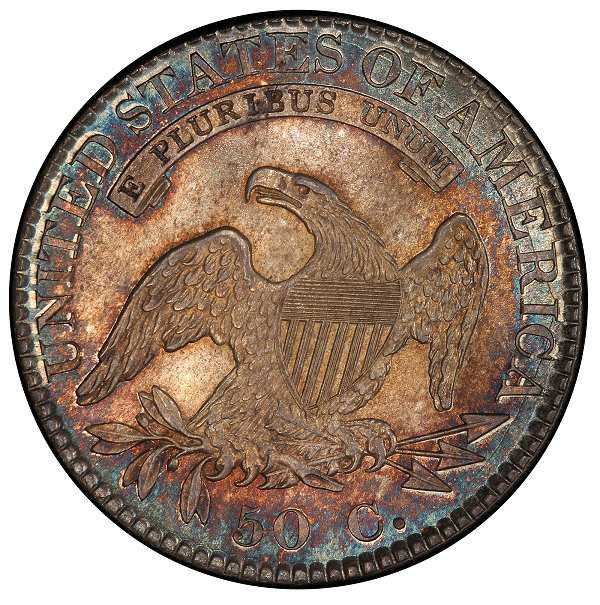
Similarly, if only three gem quality representatives of a particular date are known, a collector who is assembling a gem set may wish to pay an unprecedented ‘high’ price for one if he is concerned that one of the other two might not became available for many years.
Generally, a collector may be willing to pay a super-price in the present if he is concerned that he might not be able to soon obtain another that serves the same role in his collection, such as a particular rare date for a date set or a wonderful type coin for a type set. Even an EF-45 grade coin may realize an extremely strong price if collectors very much like that particular coin and are concerned that a ‘better coin’ of the same date or variety might not become available for a long time, if ever.
Within the least three years, there was an instance of a collector who has cancer paying an extremely strong price for a Great Rarity. He may have been worried that he would not ever have the opportunity to enjoy owning another representative of that issue. From his perspective, there was a good reason to pay a record price for that Great Rarity at the moment, regardless of how price guides, dealers or other collectors value the same coin.
As I pointed out last week, the Eliasberg-Pogue 1811 half might have realized a large premium because of its amazing originality. Others that are assigned gem grades by PCGS or NGC might not be as original.
I identify with this reason why a collector of Capped Bust halves might wish to pay a record price for that particular 1811. The originality of that coin is not revealed in price guides or in auction records for seemingly similar coins. Indeed, in regard to an amazingly original representative of a scarce issue, other survivors in the same grade range may not be nearly as original.
Originality is not of primary importance to everyone. There are collectors who will pay a tremendous premium for coins that lacks noticeable contact marks and hairlines. Others will pay premiums for coins that are extremely well struck, with noticeably more detail than other uncirculated representatives of the same issue. Still others collectors will pay premiums for coins with green toning.
Generally, coins with especially appealing or otherwise distinctive, positive characteristics are more likely to realize very strong prices than coins of the same respective dates or types that are not as distinctive.
There are coins that have very beautiful toning or ultra-dynamic luster. At auctions, it is not unusual for two bidders to become crazed about such coins. There were some spectacular silver coins in the sale of Eric Newman’s rare U.S. coins during November 2013 that brought multiples of the values of analogous coins of the same design type, the same certified grade and similar rarity.
When I wrote last week about the $558,125 result for the Pogue 1821 quarter eagle, I noted that the coin is extremely rare in all grades and that the Pogue 1821 is very lively, a coin with much personality. Although the price is very strong or extremely strong, it is unlikely that another surviving 1821 quarter eagle has nearly as much pizazz as the Pogue piece. The Pogue 1822 business strike half dollar does not have that kind of pizazz.
The Pogue 1822 business strike Half Dollar
Can the $88,125 result for the Pogue 1822 half dollar be explained in a manner that is understandable in the context of the culture of coin collecting? First, it is not one of the more scarce Capped Bust halves in this sale. Second, it may rank from third to seventh in a roster of finest known 1822 business strikes, likely fourth or fifth, maybe. Many of the other half dollars in the Pogue II sale are clearly among the three finest known of their respective ‘dates.’
Third, although the Pogue 1822 business strike has pretty toning and is a desirable coin, there are readily apparent imperfections about Miss Liberty’s face and in the right obverse field. Although these imperfections are not severe, some of the other Pogue Capped Bust half dollars are almost ‘picture-perfect.’
Fourth, several scarcer Capped Bust halves, of equivalent or superior quality, brought strong prices in this sale that were significantly less than $88,125. This “was an extremely strong price,” John Albanese remarks.
Literally, thousands of 1822 ‘normal date’ half dollars survive, if 1822 halves in all states of preservation are counted. Most collectors of Capped Bust halves in AG-03 to Fine-15 grades prefer coins that are not encapsulated.
PCGS and NGC together have graded around 1450 ‘normal date’ 1822 halves. Of this total, maybe 1100 are different coins. Overdates are not ‘normal’ dates.
The Pogue 1822 business strike half is one of two that are PCGS graded MS-66 and three are reported to have been graded as MS-67 by PCGS. NGC has certified five 1822 halves as MS-66.
CAC has approved three at the MS-66 level, including the Pogue 1822. Therefore, experts at CAC are likely to have approved at least one MS-66 grade 1822 in a NGC holder. CAC has approved a single 1822 at the MS-67 level, one of the reported three that is so graded by PCGS. It is probably true that not all of the 1822 halves certified in the MS-66 to -67 range have been submitted to CAC.
There are quite a few PCGS graded MS-66 or -66+ coins in the Pogue Collection that were previously NGC graded as MS-67. This coin, the Kaufman-“Thomas”-Pogue 1822, was NGC graded MS-67 when it was auctioned in April 2009, for $25,300, 28.7% of the price that it brought in the Pogue II event. Put differently, it brought 248% more at the Pogue II sale than the same coin realized at the ‘Central States’ sale in 2009.
Although markets for rare U.S. coins were bottoming out in April 2009, a true MS-67 grade Capped Bust half dollar from any date in the 1820s would then have been worth significantly more than $25,300. More than eighteen years earlier, in Auction ’90, Rarcoa reportedly sold a PCGS graded MS-67 1822 for more than $50,000!
It is true that the pretty natural toning impressed many who viewed this coin. Even so, several gem uncirculated 1822 halves are around, including others that are very attractive.
1819/8 Half Dollars Bring Less than the 1822
The two 1819/8 halves in this auction are the finest of any 1819/8 overdate halves of which I am aware. They each are PCGS graded MS-66 and the grade of each is in the middle of the 66 range, in my view.
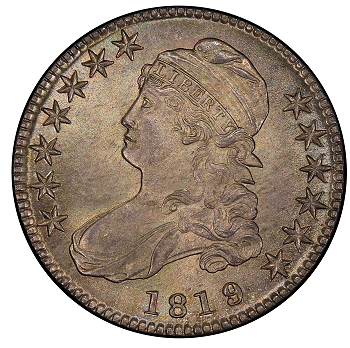 The Newman 1819/8 is close in quality. It was NGC graded as MS-65+ and CAC approved before realizing $49,937.50 on Nov. 15, 2013.
The Newman 1819/8 is close in quality. It was NGC graded as MS-65+ and CAC approved before realizing $49,937.50 on Nov. 15, 2013.
The Pogue coins are the only two 1819/8 halves that are PCGS graded as MS-66. None have been graded higher by PCGS. NGC has graded four as MS-66, one or two of which may be these Pogue Collection coins. Published data often includes multiple counts of some of the same coins. Plus, it is common knowledge that many of the coins in the Pogue Collection were in NGC holders in the past.
The Pogue 1819/8 halves each brought $41,125. It is startling and puzzling that the Pogue 1822 brought more than twice as much as either of these. These are likely to be two of the three finest known 1819/8 halves and one of the two is probably the finest known
Three 1817 Halves Each Bring less than the 1822
Two Earle-Eliasberg-Pogue 1817 ‘normal date’ halves are each PCGS graded MS-66. These are two of the three that are PCGS graded as MS-66. The lone PCGS graded MS-67 1817 ‘normal date’ was also in the Pogue Collection and in this sale!
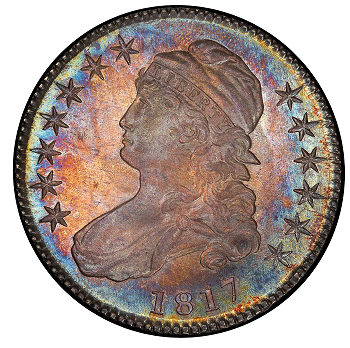 The fact that these two Earle-Eliasberg, PCGS graded MS-66 1817 halves were struck from different pairs of dies might not be relevant to outcomes in this sale. Neither die variety is close to being rare. Different die pairings used to produce the same respective dates are usually not prime factors in the market values for gem quality coins.
The fact that these two Earle-Eliasberg, PCGS graded MS-66 1817 halves were struck from different pairs of dies might not be relevant to outcomes in this sale. Neither die variety is close to being rare. Different die pairings used to produce the same respective dates are usually not prime factors in the market values for gem quality coins.
The grade of the first Earle-Eliasberg-Pogue 1817 (of die pairing O-106), which was sold as lot #2022, is around the border between MS-65 and MS-66. I figured its grade on the 65 side of the border and the price realized is consistent with my interpretation, if analyzed along with other prices in this same sale. This PCGS graded MS-66 1817 (O-106) brought $25,850.
The grade of the second PCGS graded MS-66, Earle-Eliasberg-Pogue 1817 (O-113) is definitely in the middle of the 66 range, in accordance with current standards. Indeed, in April 1997, Charlie Browne graded it as two increments higher than the just mentioned first Earle-Eliasberg-Pogue 1817, “MS-65“ versus “MS-63.” Both of these could have further naturally toned during the last eighteen years.
On April 7, 1997, the first Earle-Eliasberg 1817 (O-106) realized $4840 and the second (O-113) sold for $8250. U.S. coins in the Eliasberg sales were not graded by PCGS or NGC before the respective auctions.
On Sept. 30, 2015, the first, as was already mentioned, realized $25,850. The second “MS-66” 1817 sold for $58,750, more than twice as much as the first!
The sole PCGS graded MS-67 1817 was in the Pogue II sale and was earlier part of the Duffy Collection, which was consigned to the ANA auction of 2008. The Duffy-Pogue 1817 was then NGC certified as “MS-66*.” It was in that same NGC holder when Heritage auctioned it in January 2007 for $25,300. On July 31, 2008, perhaps the very day that markets for rare U.S. coins reached all-time peaks, the Duffy-Pogue 1817 sold for $32,200.
Neither PCGS nor NGC list any ‘normal date’ 1817 halves as grading higher than MS-67. The grade of the Duffy-Pogue coin falls around the border of MS-66 and MS-67 grades. In my view, a 66+ grade would be best.
On Sept. 30, 2014, The Duffy-Pogue 1817 brought $64,625. If its grade was solidly in the MS-67 range in the views of pertinent experts, the price realized for this coin would probably have been much higher, especially in the Pogue II sale where quite a few non-rare Capped Bust halves sold for prices in the range of $70,000 to $100,000 or more.
Even so, it is curious that a PCGS graded MS-66 1822 brought so much more than a PCGS graded MS-67 1817, especially since there are three 1822 halves certified as MS-67 while this is the only 1817 half certified as MS-67 by PCGS. Overall, 1817 ‘normal date’ halves are scarcer than 1822 ‘normal date’ halves.
‘Top’ 1821 Half Brings $64,625
The Noblet-Pogue 1821 is the only 1821 half that is PCGS graded as MS-66+ and none are grader higher by PCGS or NGC. PCGS has graded two as MS-66 and NGC reports having graded three as MS-66. This total of six in the ‘MS-66’ range probably amounts to four or five different coins. In terms of certification data, there are fewer 1821 halves in the MS-66 to MS-67 range than 1822 halves.
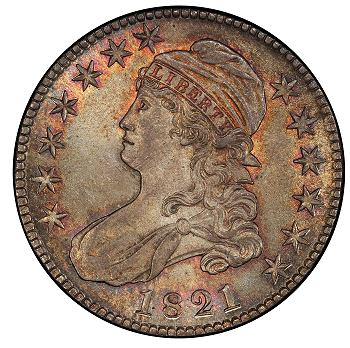 The Noblet-Pogue 1821 is a terrific coin, one of the most desirable halves in this sale. It has probably never been dipped and scores very high in the category of originality overall. Moreover, the Noblet-Pogue 1821 is very attractive with especially distinctive and cool orange tones. It is clearly of higher quality than the Pogue 1822. The Noblet-Pogue 1821 is very likely among the three finest 1821 halves known. It could very well be the finest known business strike 1821 half dollar.
The Noblet-Pogue 1821 is a terrific coin, one of the most desirable halves in this sale. It has probably never been dipped and scores very high in the category of originality overall. Moreover, the Noblet-Pogue 1821 is very attractive with especially distinctive and cool orange tones. It is clearly of higher quality than the Pogue 1822. The Noblet-Pogue 1821 is very likely among the three finest 1821 halves known. It could very well be the finest known business strike 1821 half dollar.
Although there are far more gem 1822 halves extant, it seems that the 1821 and 1822 are of similar scarcity in total, including coins in all states of preservation. By any measure, the Pogue 1821 business strike would be valued well above the Pogue 1822 business strike. Yet, this 1821 realized $64,625, more than 25% below the Pogue 1822!
Afterthoughts
It is not a matter of opinion that, in this same Pogue II event, several Capped Bust half dollars of equal or higher quality each brought less than the price paid for the Pogue “MS-66” 1822 and that a few halves that are clearly among the top three known of their respective dates brought much less than the Pogue 1822 half, which is not among the three finest known 1822 business strikes. Moreover, the Pogue 1822 business strike realized multiples of listings in price guides and much more than three times a past auction result for the very same coin in 2009.
Additionally, the $88,125 result is a multiple of respective, past and present auction results for analogous coins.
There is no question about the strength of the $88,125 result. A mystery is why the price was so strong.
Even after this auction, the PCGS price guide value for an 1822 in MS-67 grade remains at $57,500 and the listed value for a PCGS graded MS-66 1822, including the Pogue coin, is $26,500! The Numismedia retail value is around $23,000! These guide values are incorrect, of course, A middle retail value for the Pogue 1822 business strike may fall somewhere between $32,500 to $43,500. Even if PCGS upgraded it to MS-67, which is unlikely to occur, the Pogue 1822 would not have a wholesale value higher than $50,000.
There is a particular realistic possibility, however counter-intuitive, that must be considered. Research by Stephen Herrman suggests that the Pogue 1822 may be the finest known coin struck from a specific pair of dies (O-105; 5-D). Herrman does not report any others even grading as high as MS-65. I ask, regarding all 1822 halves that have been certified as grading from MS-65 to -67, has each of them been attributed by a leading specialist?
Importantly, the 1822:O-105 is not an extremely rare die pairing, as hundreds survive. Also, there are more than 450 varieties of Reich Capped Bust halves listed in standard references, some of which do not exist in gem grades.
It would be highly unusual for a collector to pay substantial premiums to place gem quality coins in a set of die varieties. Could it be true that the buyer of the Pogue 1822 business strike, or the underbidder, might have been seeking the finest known coin of this die pairing?
At least four Capped Bust halves in this sale that realized less than $88,125 are likely to each be the finest known survivors struck from a respective pair of dies. Could the Pogue 1822 be of so much higher quality than the second finest struck from the die pairing known as O-105 that two bidders would demand to pay a giant premium for it?
Overall, could there really be two bust half collectors with such an agenda, competitively seeking the finest available of each die pairing? Is there a better, rational explanation for the $88,125 price realized?
©2015 Greg Reynolds


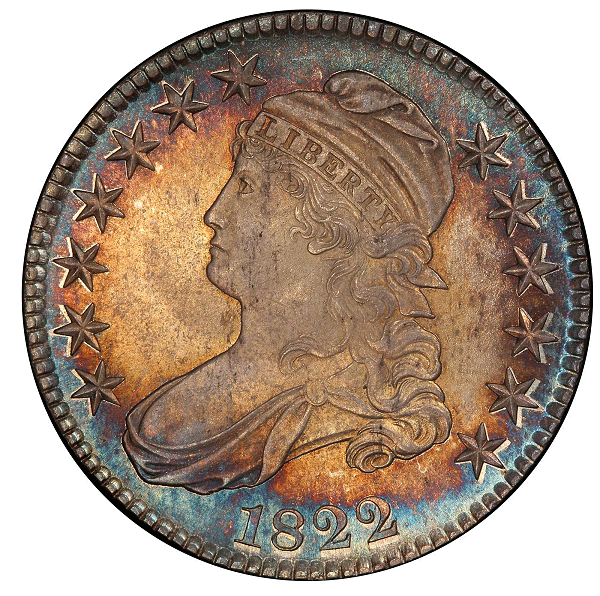



Once again Greg asks the obvious but tough questions
and then provides well thought out and detailed answers.
It’s hard to imagine that the 1822 in Greg’s opinion might
not be in the top 2-3 in the condition census for the date.
Thank you Greg for a well written and researched article.
Thank you for a very informative article..I’ve been collecting coins for a while now,and have started focusing on the bust half series! Recently I’ve acquired an UNC 1821,obverse seem like it’s got the normal slight weak spots in the hair and on a portion of the clasp.the reverse is just stunning,seems like a very early die strike.Again this article is very well written and very informative! Thanks again